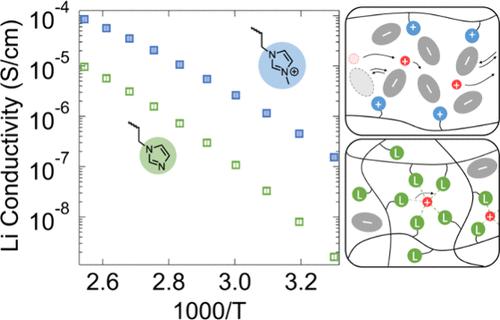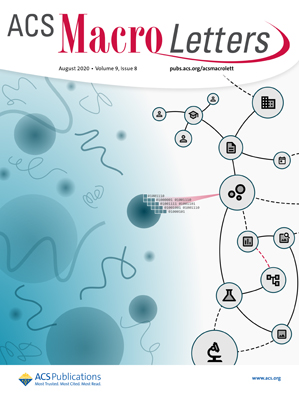将金属配位聚合物转化为聚合离子液体可改善Li+输运
IF 5.2
Q1 POLYMER SCIENCE
引用次数: 0
摘要
具有机械强度和较低易燃性的固体聚合物电解质(SPEs)也可能使下一代锂+电池具有更高的能量密度。然而,传统的固态聚合物电解质在 Li+ 传导性方面存在根本性的限制。虽然之前已证明咪唑官能化聚合物(PMS-Im)的离子导电性与咪唑-Li+ 配位有关,但我们在此证明,将这种聚合物季铵化以形成类似的咪唑官能化聚合物(PMS-Im+)可更有效地溶解锂盐并使聚合物塑化。此外,高达 10 的反向哈文比率表明 Li+ 的传输是正相关的,这可能是由于纳米通道的渗流显著提高了电池的相关电导率。在这些综合效应的作用下,PMS-Im+ 中的 Li+ 电导率(2.1 × 10-5 S/cm)比 90 °C 时的 PMS-Im 中的 Li+ 电导率(1.6 × 10-6 S/cm)高出一个数量级。本文章由计算机程序翻译,如有差异,请以英文原文为准。

Converting a Metal-Coordinating Polymer to a Polymerized Ionic Liquid Improves Li+ Transport
Solid polymer electrolytes (SPEs) with mechanical strength and reduced flammability may also enable next-generation Li+ batteries with higher energy densities. However, conventional SPEs have fundamental limitations in terms of Li+ conductivity. While an imidazole functionalized polymer (PMS-Im) has been previously shown to have ionic conductivity related to the imidazole-Li+ coordination, herein we demonstrate that quaternization of this polymer to form an analogous imidazolium functionalized polymer (PMS-Im+) more efficiently solvates lithium salts and plasticizes the polymer. In addition, inverse Haven ratios as high as 10 indicate positively correlated Li+ transport, possibly due to percolation of nanochannels that significantly improve battery-relevant conductivity. From these combined effects, Li+ conductivity in PMS-Im+ (2.1 × 10–5 S/cm) is over an order of magnitude greater than in PMS-Im at 90 °C (1.6 × 10–6 S/cm).
求助全文
通过发布文献求助,成功后即可免费获取论文全文。
去求助
来源期刊
CiteScore
10.40
自引率
3.40%
发文量
209
审稿时长
1 months
期刊介绍:
ACS Macro Letters publishes research in all areas of contemporary soft matter science in which macromolecules play a key role, including nanotechnology, self-assembly, supramolecular chemistry, biomaterials, energy generation and storage, and renewable/sustainable materials. Submissions to ACS Macro Letters should justify clearly the rapid disclosure of the key elements of the study. The scope of the journal includes high-impact research of broad interest in all areas of polymer science and engineering, including cross-disciplinary research that interfaces with polymer science.
With the launch of ACS Macro Letters, all Communications that were formerly published in Macromolecules and Biomacromolecules will be published as Letters in ACS Macro Letters.

 求助内容:
求助内容: 应助结果提醒方式:
应助结果提醒方式:


